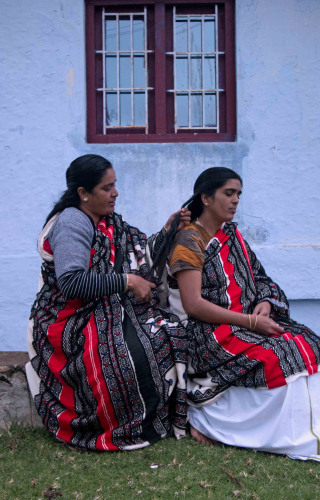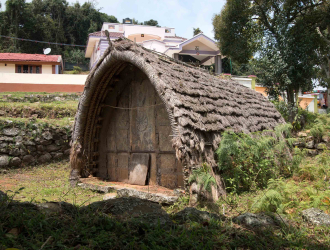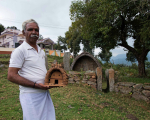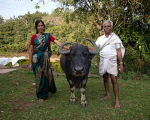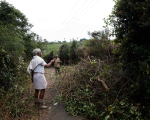For centuries, the Toda people lived in isolation in the Nilgiri Hills. The current Toda population lives in the Nilgiri Biosphere Reserve, which forms part of the Western Ghats. This region was recognised as a UNESCO World Heritage Site in 2012 due to its unique ecology and rich botanical diversity. It is here that Toda embroidery emerged as a distinct cultural practice. Toda culture is based on the symbiotic relationship they have with their natural environment. This love of the natural world is reflected in every aspect of Toda culture, including their embroidery work. Earlier the craft was exclusive to the community. However, over the last century, due to increasing contact with the outside world, Toda embroidery has now become universally popular and recognised. I have always been interested in learning about textile culture, and as part of the Frames Photography Grant, I wanted to explore Toda embroidery.
The Toda munds (village) are located in remote regions in high altitudes. Though roads connect these villages, reaching them is difficult without personal transport or without a local guide. The gateway to the Nilgiri Biosphere Reserve is via Ooty, a popular hill station which was built by the British. Interestingly, Ooty was built on land which originally belonged to the Toda people. Arrival of the British in the 1820s brought about profound changes in the habitat, lifestyle and occupation of the Toda people. There is another route via Kotagiri, which is the third-largest town in the Nilgiris.
With help from local contacts, I visited several Toda villages in Glenmorgan, Huligal and Raliya Dam. A traditional Toda hut has a distinct barrel-shaped form made using wood, rattan, bamboo and grass. Today, a Toda mund consists of mostly pukka houses made of concrete. Their temples look similar to their barrel-shaped huts. There they still perform dairy rituals during festivals.
Due to introduction of cash crop cultivation in the Nilgiris, the ecosystem of the region has changed dramatically in the last 200 years. Earlier, the Todas grazed their buffaloes in valleys of rolling montane forests separated by grasslands. These grasslands have now been replaced by tea gardens or other invasive species like Eucalyptus. This loss of pastoral lands means that the Todas do not exclusively depend on pastoralism for their sustenance. Nowadays most Toda families have taken to agriculture and maintain large plantations growing a variety of different crops. Though pastoralism has declined, water buffaloes (Bubalus bubalis) are still highly valued in Toda culture.
While Toda men attended to the buffaloes, the Toda women created beautiful embroidery work on the shawls worn by both genders, called puthkuli. The red-and-black embroidery work is executed on a white fabric base depicting a variety of motifs inspired from their pastoral lifestyle and the surrounding environment. The puthkulis are still worn by the Todas on every important rites of passage, festival or community event, and are highly valued. The Todas are landowners and they are financially well-off. Hence, few are motivated to take up embroidery work as a full-time business. Usually Toda women carry out embroidery work at home, when they have free time from their daily chores. Taking advantage of the non-monetary attitude towards their craft, attempts have been made by NGOs to ‘train’ and ‘help’ the Todas in commercialising their craft. As part of such training initiatives, the women are introduced to new designs, and embroidery work is done on a new range of products which has no relevance to Toda culture. Cooperative societies are set up which attempts to mass produce the embroidery work to cater to the tourism market. Though this might seem as social empowerment for the Todas, such practices could be lead to cultural appropriation. The Todas feel that new motifs taught by NGOs are not authentic. They feel the copying of their motifs has resulted in a loss of exclusivity of their craft. To protect their intellectual property, the embroidery work was listed as a geographically tagged product and is protected under the Geographical Indications of Goods Act (GI Act) 1999 of the Government of India. A certificate of the GI registration was formally presented to the community leaders in June 2013.
Other than agriculture and embroidery, modern Todas are engaged in various other professions. Many have moved out of their munds for higher education and jobs in cities. However, Toda societies are a close-knit unit and everyone comes together at the mund during a family event. During one of my visits, I was invited for a wedding, which was a unique experience for me. The wedding ritual takes place under a sacred grove, with the groom presenting the bride with a bow and arrow, officially marking their union. Pre-nuptial sex is not a taboo in Toda society, and the wedding rituals can take place even seven months into the pregnancy of the bride. This is an occasion for taking blessings from elders, group dancing and wearing the best puthkulis.
During my time spent with the Todas, I realised that changes in Toda culture is not just a result of integration with the outside world, but also linked to environmental degradation. For the Todas, the mountains are sacred, a place where the gods reside. That geography is now no longer sacred or exclusive, as the modern world continues to exploit their natural habitat for profit. Through this photo essay, I aim to bring to notice the sacred relationship the Todas share with their ancestral lands, and how they are trying to maintain a balance between their traditional crafts and customs and living in a modern world.
